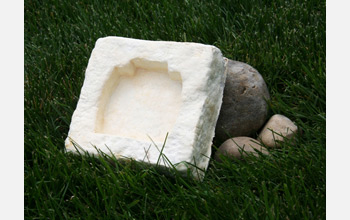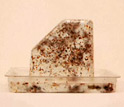News Release 10-126
Latest "Green" Packing Material? Mushrooms!
Packing foam now entering the marketplace is engineered from mushrooms and agricultural waste

EcoCradle™ packaging material is composed of agricultural byproducts bound by fungal roots.
July 26, 2010
View a time-lapse video of mushroom roots growing in a pre-designed mold.
This material is available primarily for archival purposes. Telephone numbers or other contact information may be out of date; please see current contact information at media contacts.
A new packing material that grows itself is now appearing in shipped products across the country.
The composite of inedible agricultural waste and mushroom roots is called Mycobond™, and its manufacture requires just one eighth the energy and one tenth the carbon dioxide of traditional foam packing material.
And unlike most foam substitutes, when no longer useful, it makes great compost in the garden.
The technology was the brainchild of two former Rensselaer Polytechnic Institute undergraduates, Gavin McIntyre and Eben Bayer, who founded Ecovative Design of Green Island, N.Y., to bring their idea into production.
"We don't manufacture materials, we grow them," says McIntyre. "We're converting agricultural byproducts into a higher-value product."
Because the feedstock is based on renewable resources, he adds, the material has an economic benefit as well: it is not prone to the price fluctuations common to synthetic materials derived from such sources as petroleum. "All of our raw materials are inherently renewable and they are literally waste streams," says McIntyre. "It's an open system based on biological materials."
With support from NSF, McIntyre and Bayer are developing a new, less energy-intensive method to sterilize their agricultural-waste starter material--a necessary step for enabling the mushroom fibers, called mycelia, to grow. McIntyre and Bayer are replacing a steam-heat process with a treatment made from cinnamon-bark oil, thyme oil, oregano oil and lemongrass oil.
The sterilization process, which kills any spores that could compete with Ecovative's mushrooms, is almost as effective as the autoclaving process used to disinfect medical instruments and will allow the Mycobond™ products to grow in the open air, instead of their current clean-room environment.
"The biological disinfection process simply emulates nature," says McIntyre, "in that it uses compounds that plants have evolved over centuries to inhibit microbial growth. The unintended result is that our production floor smells like a pizza shop."
Much of the manufacturing process is nearly energy-free, with the mycelia growing around and digesting agricultural starter material--such as cotton seed or wood fiber--in an environment that is both room-temperature and dark. Because the growth occurs within a molded plastic structure (which the producers customize for each application), no energy is required for shaping the products.
Once fully formed, each piece is heat-treated to stop the growth process and delivered to the customer--though with the new, easier, disinfection treatment, Bayer and McIntyre are hoping the entire process can be packaged as a kit, allowing shipping facilities, and even homeowners, to grow their own Mycobond™ materials.
Based on a preliminary assessment McIntyre and Bayer conducted under their Phase I NSF SBIR award, the improvements to the sterilization phase will reduce the energy of the entire manufacturing process to one fortieth of that required to create polymer foam.
"This project is compelling because it uses innovative technology to further improve Ecovative's value, while also providing the environmental benefits that NSF is looking for," said Ben Schrag, the NSF program officer who oversees Ecovative's Small Business Innovation Research (SBIR) award. "The traction that they have gotten with their early customers demonstrates how companies can build strong businesses around products whose primary competitive advantage lies in their sustainability."
In addition to the packaging product, called EcoCradle™, Ecovative has developed a home insulation product dubbed greensulate™. Comparable in effectiveness to foam insulation, it is also highly flame retardant.
Ecovative is already producing custom protective packaging products for several Fortune 500 companies, though they are leveraging the new disinfection process to produce turnkey systems that they plan to deploy to off-site customers and do-it-yourself homeowners by 2013.
In addition to NSF, Evocative has received support from the USDA Agricultural Research Service, the Environmental Protection Agency, and the New York State Energy Research and Development Authority.
-NSF-
-
View Video
Watch Mycobond™ packing material grow itself.
Credit and Larger Version
Media Contacts
Joshua A. Chamot, NSF, (703) 292-7730, email: jchamot@nsf.gov
Program Contacts
Benaiah Schrag, NSF, (703) 292-8323, email: bschrag@nsf.gov
Principal Investigators
Gavin McIntyre, Ecovative Design, (518) 273-3753, email: gavin@ecovativedesign.com
Co-Investigators
Eben Bayer, Ecovative Design, (518) 273-3753, email: eben@ecovativedesign.com
The U.S. National Science Foundation propels the nation forward by advancing fundamental research in all fields of science and engineering. NSF supports research and people by providing facilities, instruments and funding to support their ingenuity and sustain the U.S. as a global leader in research and innovation. With a fiscal year 2023 budget of $9.5 billion, NSF funds reach all 50 states through grants to nearly 2,000 colleges, universities and institutions. Each year, NSF receives more than 40,000 competitive proposals and makes about 11,000 new awards. Those awards include support for cooperative research with industry, Arctic and Antarctic research and operations, and U.S. participation in international scientific efforts.
Connect with us online
NSF website: nsf.gov
NSF News: nsf.gov/news
For News Media: nsf.gov/news/newsroom
Statistics: nsf.gov/statistics/
Awards database: nsf.gov/awardsearch/
Follow us on social
Twitter: twitter.com/NSF
Facebook: facebook.com/US.NSF
Instagram: instagram.com/nsfgov



